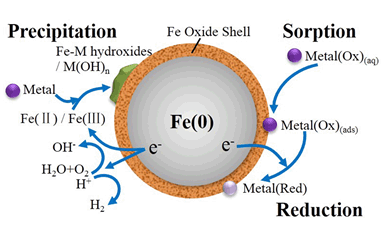| [1] Agarwal, S. K. Heavy Metal Pollution, APH publishing, New Delhi, 2009.
[2] Asrari, E. Heavy Metal Contamination of Water and Soil:Analysis, Assessment, and Remediation Strategies, CRC Press, 2014.
[3] Fu, J. J.; Wang, Y. W.; Zhou, L. J.; Zhang, A. Q.; Jiang, G. B. Prog. Chem. 2011, 23, 1756(in Chinese). (傅建捷, 王亚韡, 周麟佳, 张爱茜, 江桂斌, 化学进展, 2011, 23, 1756.)
[4] Rodríguez-Lado, L.; Sun, G.; Berg, M.; Zhang, Q.; Xue, H.; Zheng, Q.; Johnson, C. A. Science 2013, 341, 866.
[5] Cullen, W. R.; Reimer, K. J. Chem. Rev. 1989, 89, 713.
[6] Kotas, J.; Stasicka, Z. Environ. Pollut. 2000, 107, 263.
[7] Järup, L. Brit. Med. Bull. 2003, 68, 167.
[8] Goyer, R.; Golub, M.; Choudhury, H.; Hughes, M.; Kenyon, E.; Stifelman, M. In US Environmental Protection Agency, Risk Assessment Forum, Vol. 1200, Washington, DC, 2004.
[9] El Samrani, A. G.; Lartiges, B. S.; Villiéras, F. Water Res. 2008, 42, 951.
[10] Matlock, M. M.; Howerton, B. S.; Atwood, D. A. Water Res. 2002, 36, 4757.
[11] Fu, F.; Wang, Q. J. Environ. Manage. 2011, 92, 407.
[12] Liu, Y.; Liang, P.; Guo, L.; Lu, H. B. Acta Chim. Sinica 2005, 63, 312(in Chinese). (刘艳, 梁沛, 郭丽, 卢汉兵, 化学学报, 2005, 63, 312.)
[13] Wan, Q. F.; Ren, Y. M.; Wang, L.; Jiang, H. Z.; Deng, D. C.; Bai, Y.; Xia, C. Q. Acta Chim. Sinica 2011, 69, 1780(in Chinese). (万芹方, 任亚敏, 王亮, 姜海洲, 邓大超, 柏云, 夏传琴, 化学学报, 2011, 69, 1780.)
[14] Li, X. Q.; Zhang, W. X. J. Phys. Chem. C 2007, 111, 6939.
[15] Yan, W. L.; Herzing, A. A.; Kiely, C. J.; Zhang, W. X. J. Contam. Hydrol. 2010, 118, 96.
[16] Li, S. L.; Wang, W.; Liang, F. P.; Zhang, W. X. J. Hazard. Mater. 2017, 322, 163.
[17] Hua, M.; Zhang, S. J.; Pan, B. C.; Zhang, W. M.; Lv, L.; Zhang, Q. -X. J. Hazard. Mater. 2012, 211, 317.
[18] Choi, C. J.; Dong, X. L.; Kim, B. K. Mater. Trans. 2001, 42, 2046.
[19] Crane, R.; Dickinson, M.; Popescu, I.; Scott, T. Water Res. 2011, 45, 2931.
[20] Glavee, G. N.; Klabunde, K. J.; Sorensen, C. M.; Hadjipanayis, G. C. Inorg. Chem. 1995, 34, 28.
[21] Karlsson, M.; Deppert, K.; Wacaser, B.; Karlsson, L.; Malm, J. O. Appl. Phys. A 2005, 80, 1579.
[22] Kuhn, L. T.; Bojesen, A.; immermann, L.; Nielsen, M. M. J. Phys.:Condens. Matter 2002, 14, 13551.
[23] Carpenter, E.; Calvin, S.; Stroud, R.; Harris, V. Chem. Mater. 2003, 15, 3245.
[24] Nurmi, J. T.; Tratnyek, P. G.; Sarathy, V.; Baer, D. R.; Amonette, J. E.; Pecher, K.; Wang, C.; Linehan, J. C.; Matson, D. W.; Penn, R. L. Environ. Sci. Technol. 2005, 39, 1221.
[25] Wang, C.; Baer, D. R.; Amonette, J. E.; Engelhard, M. H.; Antony, J.; Qiang, Y. J. Am. Chem. Soc. 2009, 131, 8824.
[26] Zhdanov, V. P.; Kasemo, B. Chem. Phys. Lett. 2008, 452, 285.
[27] Wang, C. M.; Baer, D. R.; Thomas, L. E.; Amonette, J. E.; Antony, J.; Qiang, Y.; Duscher, G. J. Appl. Phys. 2005, 98, 094308.
[28] Wang, Q.; Kanel, S. R.; Park, H.; Ryu, A.; Choi, H. J. Nanopart. Res. 2009, 11, 749.
[29] Ling, L.; Pan, B. C.; Zhang, W. X. Water Res. 2015, 71, 274.
[30] Ling, L.; Zhang, W. X. Environ. Sci. Technol. Lett. 2014, 1, 209.
[31] Ling, L.; Zhang, W. X. J. Am. Chem. Soc. 2015, 137, 2788.
[32] Chen, G. Sep. Purif. Technol. 2004, 38, 11.
[33] Grosvenor, A.; Kobe, B.; McIntyre, N. Surf. Sci. 2004, 572, 217.
[34] Liu, A.; Zhang, W. X. Analyst 2014, 139, 4512.
[35] Scherer, M. M.; Balko, B. A.; Tratnyek, P. G. The Role of Oxides in Reduction Reactions at the Metal-Water Interface, ACS Symposium Series, American Chemical Society, 1998.
[36] Loyaux-Lawniczak, S.; Refait, P.; Ehrhardt, J. J.; Lecomte, P.; Génin, J. M. R. Environ. Sci. Technol. 2000, 34, 438.
[37] Melitas, N.; Chuffe-Moscoso, O.; Farrell, J. Environ. Sci. Technol. 2001, 35, 3948.
[38] Li, X. Q.; Zhang, W. X. Langmuir 2006, 22, 4638.
[39] Fan, H. J.; Gösele, U.; Zacharias, M. Small 2007, 3, 1660.
[40] Yin, Y.; Rioux, R. M.; Erdonmez, C. K.; Hughes, S.; Somorjai, G. A.; Alivisatos, A. P. Science 2004, 304, 711. |
